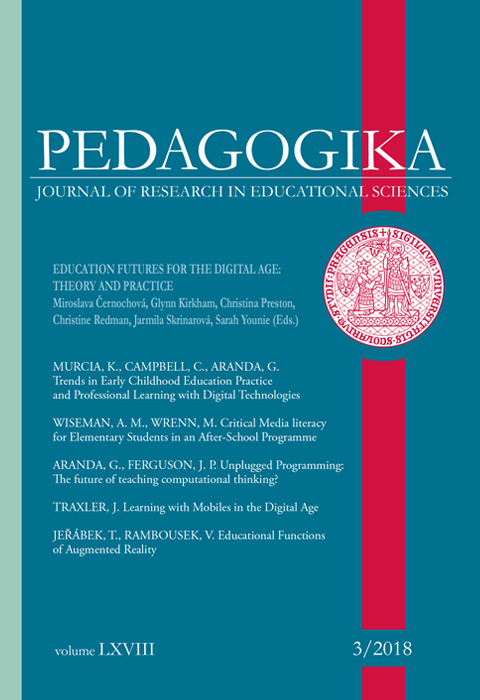Educational Functions of Augmented Reality
DOI:
https://doi.org/10.14712/23362189.2018.861Keywords:
augmented reality systems, educational function, didactic specifi cs, application, learningAbstract
The theoretical study presented in this paper focuses on the use of augmented reality systems in education. It analyses the specifi c characteristics of augmented reality and, in the context of these parameters, it formulates didactic specifi cs of augmented reality given by the complex of didactically relevant parameters of the didactic means that distinguish it from other devices in terms of supporting the accomplishment of educational intentions. Th e paper also defi nes educational intentions of using augmented reality for increasing the informational value, exposition of temporally and spatially disparate processes and phenomena, simulations of phenomena, events and processes, acquisition and building of competence in specifi c situations and instructing in activities. Following the educational intentions, the paper also proposes complex organisational criteria for the use of augmented reality applications, which include, in particular, the proposed location for the implementation of augmented reality, the number of students for whom augmented reality is intended, the anticipated role of a student in augmented reality, required mobility and required parameters of content presentation.
References
Azuma, R. T. (1997). A survey of augmented reality. Teleoperators and Virtual Environments, 6.
https://doi.org/10.1162/pres.1997.6.4.355
Barroso Osuna, J. M., & Gallego Pérez, O. M. (2017). Producción de recursos de aprendizaje apoyados en Realidad Aumentada por parte de estudiantes de magisterio. Revista de Educación Mediática y TIC, 6(1), 23-38.
Bimber, O., & Raskar, R. (2005). Spatial augmented reality: merging real and virtual worlds. A. K. Peters.
https://doi.org/10.1201/b10624
Breen, D. E., et al. (1996). Interactive Occlusion and Automatic Object Placement for Augmented Reality. Computer Graphics Forum (Proc. Eurographics '96), 15(3), 11-22.
https://doi.org/10.1111/1467-8659.1530011
Brown, D. G., Coyne, J. T., & Stripling. R. (2006). Augmented reality for urban skills training. VR '06: Proceedings of the IEEE conference on Virtual Reality (p. 249-252).
https://doi.org/10.1109/VR.2006.28
Cabero, J., & Barroso, J. (2016). The educational possibilities of augmented reality. Journal of New Approaches in Educational Research, 5(1), 44-50.
Drascic, D., & Milgram, P. (1996). Perceptual issues in augmented reality. SPIE Volume 2653: Stereoscopic Displays and Virtual Reality Systems III.
Dunleavy, M., Dede, C., & Mitchell, R. (2009). Affordances and limitations of immersive participatory augmented reality simulations for teaching and learning. Journal of Science Education and Technology, 18(1), 7-22.
https://doi.org/10.1007/s10956-008-9119-1
Heim, M. (1998). Virtual realism. New York: Oxford University Press.
Hong, K., Yeom, J., Jang, C., Hong, J., & Lee, B. (014). Full-color lens-array holographic optical element for three-dimensional optical see-through augmented reality. Optics Letters, 39, 127-130.
https://doi.org/10.1364/OL.39.000127
PMid:24365839
Hughes, C. E., Stapleton, C. B., Hughes, D. E., & Smith, E. M. (2005). Mixed reality in education, entertainment, and training. IEEE Comput. Graph. Appl., 25, 24-30.
https://doi.org/10.1109/MCG.2005.139
PMid:16315474
Jeřábek, T., Prokýšek, M., & Rambousek, V. (2013). Parameters of augmented reality and its use in education. Journal on Efficiency and Responsibility in Education and Science, 6(4), 232-244.
https://doi.org/10.7160/eriesj.2013.060403
Jeřábek, T., Rambousek, V., & Wildová, R. (2015). Perceptual specifics and categorisation of augmented reality systems. Procedia – Social and Behavioral Sciences, 191, 1740-1744.
https://doi.org/10.1016/j.sbspro.2015.04.419
Johnson, L., Adams Becker, S., Cummins, M., Estrada, V., Freeman, A., & Hall, C. (2016). NMC horizon report: higher education edition. Austin, Texas: The New Media Consortium.
Kaufmann, H. (2004). Geometry education with augmented reality. Wien: Springer.
Laurel, B. (1993). Computers as theatre. Boston: Addison-Wesley Professional.
PMid:8349811 PMCid:PMC294906
Lévy, P. (2000). Kyberkultura. Praha: Karolinum.
Liou, H.-H., Yang, S. J. H., Chen, S. Y., & Tarng, W. (2017). The influences of the 2D image-based augmented reality and virtual reality on student learning. Journal of Educational Technology and Society, 20(3), 110-121.
Lister, M., Dovey, J., Giddings, S., Grant, I., & Kelly, K. (2009). New media: a critical introduction. 2nd ed. London: Routledge.
Martín-Gutiérrez, J., Mora, C. E., Anorbe-Díaz, B., & Gonzáles-Marrero, A. (2017). Virtual technologies trends in education. EURASIA Journal of Mathematics Science and Technology Education, 13(2), 469-486.
https://doi.org/10.12973/eurasia.2017.00626a
Milgram, P. (1994). A taxonomy of mixed reality visual displays. IEICE Transactions on Information Systems, E77-D(12).
Moore, M. G. (1989). Three types of interaction. American Journal of Distance Education, 3(2).
https://doi.org/10.1080/08923648909526659
Oh, K. E. et al. (2011). Which properties in 3D visualizations cause comprehension difficulties? Proceedings of the American Society for Information Science and Technology, 48(1), 1-4.
https://doi.org/10.1002/meet.14505001068
https://doi.org/10.1002/meet.2009.14504603101
https://doi.org/10.1002/meet.2009.1450460393
https://doi.org/10.1002/meet.2014.14505101068
https://doi.org/10.1002/meet.2014.14505101139
https://doi.org/10.1002/meet.14505001130
https://doi.org/10.1002/meet.2011.14504801313
https://doi.org/10.1002/meet.2011.14504801345
https://doi.org/10.1002/meet.14505001138
https://doi.org/10.1002/meet.14504901253
https://doi.org/10.1002/meet.14504901326
https://doi.org/10.1002/meet.14504901075
https://doi.org/10.1002/meet.14504901316
https://doi.org/10.1002/meet.2011.14504801136
https://doi.org/10.1002/meet.2011.14504801269
Prokýšek, M., Rambousek, V., & Wildová, R. (2013). Research into spatial intelligence and the efficiency of the application of spatial visualization in instruction. Procedia – Social and Behavioral Sciences, 84, 855-859.
https://doi.org/10.1016/j.sbspro.2013.06.661
Rolland, J. P., & Hua, H. (2005/2003). Head-mounted display systems. In R. Driggers (Ed.), Encyclopedia of Optical Engineering (p. 1-13). New York: Marcel Dekker.
PMid:16766816
Ryan, M. L. (1994). Immersion vs. interactivity: virtual reality and literary theory [online]. Available from www.humanities.uci.edu
Yacci, M. (2000). Interactivity demystified: A structural definition for distance education and intelligent CBT. Educational Technology.
Zhen, B., & Blackwell, A. F. (2013). See-through window vs. magic mirror: A comparison in supporting visual-motor tasks. Mixed and Augmented Reality (ISMAR). IEEE International Symposium (p. 239-240).
PMid:23830445



